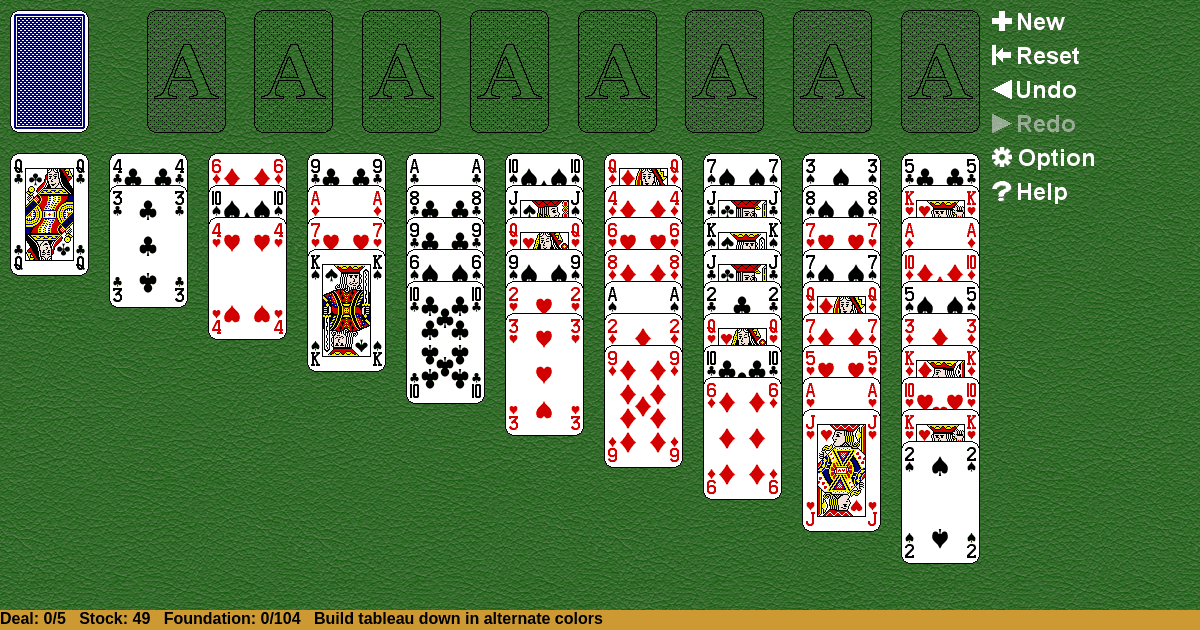Eternal Triangle
Home |
How to play |
FAQ |
About
How to play Eternal Triangle?
Game Objective:
The primary goal in Eternal Triangle Solitaire is to move all cards from the tableau and stock to the foundation piles, building each foundation up by suit from Ace to King.
Setup & Layout:
- Deck Used: One standard 52-card deck is used.
- Tableau: There are ten tableau piles. The tableau is constructed as follows:
- The first tableau pile receives 1 card, the second receives 2 cards, the third receives 3 cards, and so on, up to the tenth pile, which receives 10 cards.
- All cards in the tableau are dealt face-up, making every card visible and available for play.
- Foundations: There are four foundation piles, one for each suit. These start empty.
- Stock: The remaining cards after the tableau is dealt form the stock pile, placed face-down.
- Waste: When cards are drawn from the stock and cannot be played, they are placed face-up into the waste pile.
Key Play Areas:
- Tableau: The main area where cards are arranged and manipulated.
- Foundations: The destination piles for building each suit in order.
- Stock: The draw pile for additional cards.
- Waste: The pile for unplayable cards drawn from the stock.
Eternal Triangle Solitaire Rules:
- Tableau Building: Cards in the tableau are built down by alternating color (e.g., a red card on a black card, and vice versa).
- Moving Cards: Only sequences of cards that are in correct descending order and alternating colors may be moved together as a group between tableau piles.
- Single Card Moves: Individual cards can also be moved if they follow the descending, alternating color rule.
- Foundations: Foundations are built up by suit, starting from Ace and proceeding in ascending order to King (A-2-3-…-K).
- Stock and Waste: Cards from the stock are dealt one at a time to the waste pile. Only the top card of the waste is available for play to either the tableau or the foundation.
Gameplay:
- Player Actions:
- Move available cards or valid sequences within the tableau, following the descending order and alternating color rule.
- Move eligible cards from the tableau or waste to the foundations, building up by suit.
- Draw cards from the stock one at a time, placing each on the waste pile.
- Use the top card of the waste pile for moves to the tableau or foundations.
- Introducing New Cards:
- When no more moves are possible within the tableau, the player draws from the stock to the waste.
- No More Legal Moves:
- If the stock is exhausted and no further moves can be made within the tableau or from the waste, play ends.
Winning & Losing Conditions:
- Winning: The game is won when all 52 cards are moved to the four foundation piles, each built up by suit from Ace to King.
- Losing/Unwinnable State: The game is lost if all cards cannot be moved to the foundations and no further legal moves are possible (i.e., the stock is empty and no tableau or waste moves remain).
Special Rules & Edge Cases:
- Filling Empty Tableau Spaces: Only Kings may be placed into empty tableau piles. No other card or sequence can fill an empty tableau space.
- Moving Groups: Groups of cards may only be moved together if they are in perfect descending order and alternate in color.
- Stock Limitations: There is typically no redeal; once the stock is exhausted, no more cards can be drawn.
- Waste Pile Use: Only the top card of the waste pile is available for play at any time.
Summary of Unique Features:
- Tableau piles increase in size from 1 to 10 cards, all face-up.
- Tableau builds down by alternating color; only Kings fill empty tableau spaces.
- Foundations build up by suit from Ace to King.
- Only sequences in correct order and color may be moved as a group.
- No redeal of the stock.
This ruleset defines the unique structure and play of Eternal Triangle Solitaire, distinguishing it from other solitaire variants.

Solitaire Collection
About Eternal Triangle
Rate (Eternal Triangle)
4.7 / 5
1,916 votes



























































